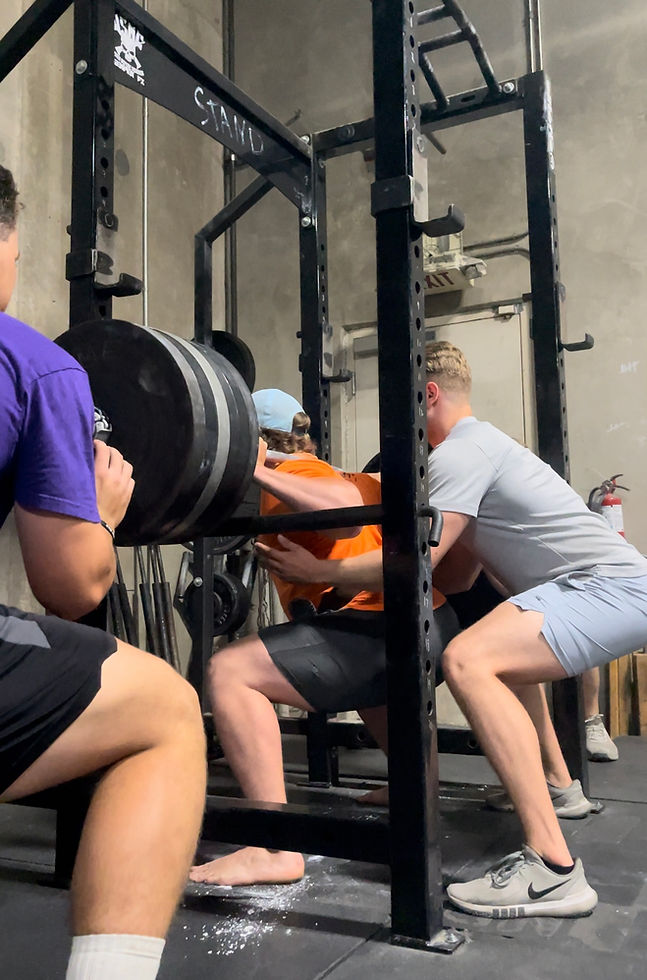
🔥 Maximal Strength Method: Why, When, and How
- Adam Fenske
- Sep 6, 2025
- 3 min read
According to the Science and Practice of Strength Training, “Lifting maximal loads (at or above 90%) is considered superior for improving both intramuscular and intermuscular coordination; the muscles and CNS adapt only to the load placed upon them. This method should be used to bring forth the greatest strength increments. CNS inhibition, if it exists, is reduced with this approach; thus, the maximal number of motor units is activated with optimal discharge frequency and the biomechanical parameters of movement and intermuscular coordination are similar to the analogous values in a main sport exercise.”
The Maximal Strength Method, better known as “Max Effort” is critical, because as Dr. Mel Siff, author of “Supertraining” describes, maximal strength is the “mother of all strengths”, meaning every other strength on the Force-Velocity curve: strength-speed (ie sprinting up a hill), speed-strength (the optimal relationship of force-velocity, aka power: swinging a bat or throwing a baseball), and explosive strength (jumping, maximal velocity sprinting) is improved by increasing maximal strength.
So how to appropriately use the Maximal Strength Method? First, a few parameters:
- The Maximal Strength Method is not
recommended for beginners, as they haven’t built the relevant musculature that allows them to perform high intensities with safe technique.
- Main, multi-joint, full body movements such as squat or deadlift should be selected: you wouldn’t do maximal strength with an isolation movement like a dumbbell curl.
- The exercises used must be rotated week to week. This is because of The Law of Accommodation, which states that response to stimulus decreases over time: for an advanced athlete, even performing the same exercise for maximal strength in a given year will not yield good results. We rotate our exercises by performing ones that are alike in nature to main movements, but aren’t the same. For example, we’ll alter the leverage point (i.e. squat to a low box) or change the strength curve (i.e. squatting against bands, forcing the athlete to apply more force as the band tension increases).
- Maximal Strength must be coached. A Coach providing the correct cue at the correct time in the lift, as well as providing feedback after each lift, allows an athlete to perform the lift with good technique, and aggression. This leads to drastically better results versus an athlete getting out of
position and sloppy with their technique, which hurts performance, and is potentially dangerous with heavy weights.
- Always make sure to have competent, engaged spotters ensuring safety
In the case of using singles for max effort, after warming up, the athlete will triple up until they reach a weight they’re unsure they can perform a triple with. They will then perform 2-3 singles at a perceived 90% or above. In addition to providing technique cueing and feedback, the coach should monitor bar speed. It’s critical to keep the top single to 95% or less: the recovery for a 100%, grinded out slow single is a full 10 days for the CNS, whereas a single at 95% or less, is just 2 days.
Secondly, performing lifts at 100%, known as “limit strength”, which is producing a high amount of force regardless of time, is useful only for competitive powerlifters-performing limit strength as a field athlete is counterproductive. A good gauge of 95% is the bar clips, but doesn’t grind. The athlete will also express that they feel they “can do one more”. At that point in our programming an athlete moves on to address his individual needs and weak points. Max Effort isn’t about performing go for broke singles, it’s about handling a strong single performed with good technique.
How often should you perform Maximal Strength? It depends on your goals, but research indicates that the residual effect of maximal strength is 30 days +/- 5 days. However, in my experience its more around 14 days. Remember, consistently training maximal strength is a must, because every other quality diminishes without it, including all critical power (speed-strength). Succeeding at the elite levels of sport is difficult enough without dropping key physical attributes: staying strong is a must!
-Fenske





Comments